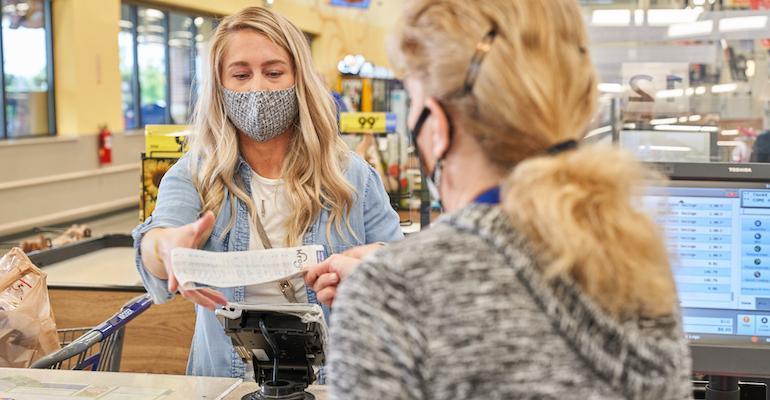Next year, U.S. shoppers anticipate spending 14% more on average per month for their groceries, according to the KPMG Consumer Pulse Survey 2022 Grocery Forecast.
Based on a poll of more than 1,000 consumers, the average monthly grocery spend is pegged at $611 for 2022 versus $532 in 2021, KPMG’s report said. Most respondents estimate they will spend $101 to $500 per month on groceries next year, including 33% spending $101 to $300 (versus 36% in 2021) and 22% spending $301 to $500 (versus 24% in 2021).
When asked how much they think grocery spend will change in 2022 from before the COVID-19 pandemic, those surveyed said on average they expect a 22% increase, compared with a 15% estimated uptick from 2019 to 2020. Consumers’ expected spending increases for grocery in 2022 were well above those predicted for other categories, including expenditure hikes of 14% for personal care products, 10% for apparel, 9% for prescription drugs, 8% for restaurants, 6% for electronics/appliances and 3% apiece for entertainment/media and furniture/home improvement, global business consulting and services firm KPMG found.

From January 2020 to September 2021, grocery sales via online channels saw the greatest percentage increase — topping 200% at some points during that time span — followed by prepared meal/meal kit services, warehouse club chains, GM/mass merchant stores, supermarkets and discount grocers, according to KPMG.
Industrywide, the number of customers rose 5% from January 2020 to September 2021, led by online grocery and meal service channels, the study showed. Average transaction value dipped 1% from $66.51 to $65.93 over that time span, with club and online channels tallying the highest percentage growth in basket size, while transaction count per customer edged up 2% from 3.23 to 3.28, led by supermarkets and mass merchants.
“In 2021, we reported on how COVID-19 and its ripple effects across the economy produced large shifts in consumer behaviors around food shopping and eating, which resulted in a boom for grocers. Grocers experienced significant increases in sales as many consumers began eating at home for all three meals in the day,” KPMG said in its 2022 grocery forecast report. “With so many consumers able to work from home and with their anticipation of rising prices factoring into their budgets, overall grocery spend is expected to be higher year over year compared to 2021.
“Omicron variant aside, as consumers spend more time away from home, more of their food consumption is also expected to be out of the home,” KMPG noted. “In our latest survey data, consumers signal they expect to see increases in restaurant budgets in the upcoming months. And mobility and credit card data reinforce this trend.”

Indeed, KPMG’s research revealed that consumers are cooking roughly 64% of their meals at home, compared with 10% of their meals from dining out, 12% from takeout (pickup) and 10% from delivery. Breakfast (70%) and snacks (69%) had the highest at-home percentages, while dinner (12%) and lunch (11%) saw the largest dining out shares of meals. Dinner and lunch, too, accounted for the biggest percentages of delivery (12% and 11%, respectively) and pickup (13% for both).
“While grocery spend was up significantly during COVID-19, we expect the trajectory to decline as consumers go back to both full- and limited-service restaurants,” KPMG observed in the study.
Consumer spending for limited-service restaurants is up more than 20% from March to September 2021 versus single digits for grocery stores and full-service restaurants, the report indicated. Foot traffic for food-at-home and away-from-home channels plunged in 2020 but rebounded this year, up 41% for grocery stores and and 52% for restaurants between January and August 2021.
“In looking ahead to 2022, however, consumers do not cite dramatic increases in food away from home, with the number of consumers saying they will cook a lot more or more is still significant,” KPMG stated.

Among survey respondents, 35% said they plan cook/prepare dinner and 32% plan to cook/prepare lunch more often in 2022, versus 26% dining out more for dinner and 24% eating out more for lunch. On the takeout side, 21% and 22% respectively expect to be buying dinner for delivery and pickup more often, compared with 20% and 21% respectively for lunch.
“While one might expect grocery budgets to decline as consumers spend more time away from home, this net increase is a result of a confluence of both headwinds and tailwinds affecting the industry,” KMPG pointed out.
“Many consumers are still able and prefer to work from home at levels much higher than pre-COVID. Sixty-two percent of our survey respondents stated they are able to work from home, and of those over half suggested they work from home 100% of the time,” the report said of tailwinds for the grocery industry. In terms of headwinds, the study said, “Consumers indicate that across eating occasions, more consumption will be ‘away from home’ compared to 2021, indicating some pickup in restaurant demand. Foot traffic to restaurants, depressed during much of COVID-19, in the past couple of months it has picked up substantially.”





